Yihua Shao
MambaIC: State Space Models for High-Performance Learned Image Compression
Mar 16, 2025Abstract:A high-performance image compression algorithm is crucial for real-time information transmission across numerous fields. Despite rapid progress in image compression, computational inefficiency and poor redundancy modeling still pose significant bottlenecks, limiting practical applications. Inspired by the effectiveness of state space models (SSMs) in capturing long-range dependencies, we leverage SSMs to address computational inefficiency in existing methods and improve image compression from multiple perspectives. In this paper, we integrate the advantages of SSMs for better efficiency-performance trade-off and propose an enhanced image compression approach through refined context modeling, which we term MambaIC. Specifically, we explore context modeling to adaptively refine the representation of hidden states. Additionally, we introduce window-based local attention into channel-spatial entropy modeling to reduce potential spatial redundancy during compression, thereby increasing efficiency. Comprehensive qualitative and quantitative results validate the effectiveness and efficiency of our approach, particularly for high-resolution image compression. Code is released at https://github.com/AuroraZengfh/MambaIC.
WonderVerse: Extendable 3D Scene Generation with Video Generative Models
Mar 13, 2025Abstract:We introduce \textit{WonderVerse}, a simple but effective framework for generating extendable 3D scenes. Unlike existing methods that rely on iterative depth estimation and image inpainting, often leading to geometric distortions and inconsistencies, WonderVerse leverages the powerful world-level priors embedded within video generative foundation models to create highly immersive and geometrically coherent 3D environments. Furthermore, we propose a new technique for controllable 3D scene extension to substantially increase the scale of the generated environments. Besides, we introduce a novel abnormal sequence detection module that utilizes camera trajectory to address geometric inconsistency in the generated videos. Finally, WonderVerse is compatible with various 3D reconstruction methods, allowing both efficient and high-quality generation. Extensive experiments on 3D scene generation demonstrate that our WonderVerse, with an elegant and simple pipeline, delivers extendable and highly-realistic 3D scenes, markedly outperforming existing works that rely on more complex architectures.
GM-MoE: Low-Light Enhancement with Gated-Mechanism Mixture-of-Experts
Mar 10, 2025Abstract:Low-light enhancement has wide applications in autonomous driving, 3D reconstruction, remote sensing, surveillance, and so on, which can significantly improve information utilization. However, most existing methods lack generalization and are limited to specific tasks such as image recovery. To address these issues, we propose \textbf{Gated-Mechanism Mixture-of-Experts (GM-MoE)}, the first framework to introduce a mixture-of-experts network for low-light image enhancement. GM-MoE comprises a dynamic gated weight conditioning network and three sub-expert networks, each specializing in a distinct enhancement task. Combining a self-designed gated mechanism that dynamically adjusts the weights of the sub-expert networks for different data domains. Additionally, we integrate local and global feature fusion within sub-expert networks to enhance image quality by capturing multi-scale features. Experimental results demonstrate that the GM-MoE achieves superior generalization with respect to 25 compared approaches, reaching state-of-the-art performance on PSNR on 5 benchmarks and SSIM on 4 benchmarks, respectively.
TR-DQ: Time-Rotation Diffusion Quantization
Mar 09, 2025Abstract:Diffusion models have been widely adopted in image and video generation. However, their complex network architecture leads to high inference overhead for its generation process. Existing diffusion quantization methods primarily focus on the quantization of the model structure while ignoring the impact of time-steps variation during sampling. At the same time, most current approaches fail to account for significant activations that cannot be eliminated, resulting in substantial performance degradation after quantization. To address these issues, we propose Time-Rotation Diffusion Quantization (TR-DQ), a novel quantization method incorporating time-step and rotation-based optimization. TR-DQ first divides the sampling process based on time-steps and applies a rotation matrix to smooth activations and weights dynamically. For different time-steps, a dedicated hyperparameter is introduced for adaptive timing modeling, which enables dynamic quantization across different time steps. Additionally, we also explore the compression potential of Classifier-Free Guidance (CFG-wise) to establish a foundation for subsequent work. TR-DQ achieves state-of-the-art (SOTA) performance on image generation and video generation tasks and a 1.38-1.89x speedup and 1.97-2.58x memory reduction in inference compared to existing quantization methods.
In-Context Meta LoRA Generation
Jan 30, 2025



Abstract:Low-rank Adaptation (LoRA) has demonstrated remarkable capabilities for task specific fine-tuning. However, in scenarios that involve multiple tasks, training a separate LoRA model for each one results in considerable inefficiency in terms of storage and inference. Moreover, existing parameter generation methods fail to capture the correlations among these tasks, making multi-task LoRA parameter generation challenging. To address these limitations, we propose In-Context Meta LoRA (ICM-LoRA), a novel approach that efficiently achieves task-specific customization of large language models (LLMs). Specifically, we use training data from all tasks to train a tailored generator, Conditional Variational Autoencoder (CVAE). CVAE takes task descriptions as inputs and produces task-aware LoRA weights as outputs. These LoRA weights are then merged with LLMs to create task-specialized models without the need for additional fine-tuning. Furthermore, we utilize in-context meta-learning for knowledge enhancement and task mapping, to capture the relationship between tasks and parameter distributions. As a result, our method achieves more accurate LoRA parameter generation for diverse tasks using CVAE. ICM-LoRA enables more accurate LoRA parameter reconstruction than current parameter reconstruction methods and is useful for implementing task-specific enhancements of LoRA parameters. At the same time, our method occupies 283MB, only 1\% storage compared with the original LoRA.
3DSceneEditor: Controllable 3D Scene Editing with Gaussian Splatting
Dec 02, 2024
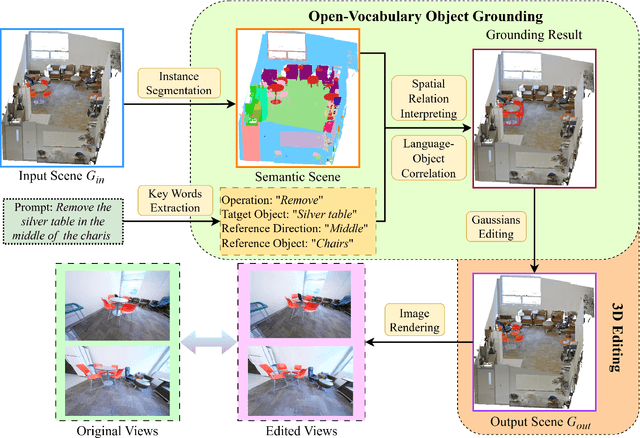


Abstract:The creation of 3D scenes has traditionally been both labor-intensive and costly, requiring designers to meticulously configure 3D assets and environments. Recent advancements in generative AI, including text-to-3D and image-to-3D methods, have dramatically reduced the complexity and cost of this process. However, current techniques for editing complex 3D scenes continue to rely on generally interactive multi-step, 2D-to-3D projection methods and diffusion-based techniques, which often lack precision in control and hamper real-time performance. In this work, we propose 3DSceneEditor, a fully 3D-based paradigm for real-time, precise editing of intricate 3D scenes using Gaussian Splatting. Unlike conventional methods, 3DSceneEditor operates through a streamlined 3D pipeline, enabling direct manipulation of Gaussians for efficient, high-quality edits based on input prompts.The proposed framework (i) integrates a pre-trained instance segmentation model for semantic labeling; (ii) employs a zero-shot grounding approach with CLIP to align target objects with user prompts; and (iii) applies scene modifications, such as object addition, repositioning, recoloring, replacing, and deletion directly on Gaussians. Extensive experimental results show that 3DSceneEditor achieves superior editing precision and speed with respect to current SOTA 3D scene editing approaches, establishing a new benchmark for efficient and interactive 3D scene customization.
GWQ: Gradient-Aware Weight Quantization for Large Language Models
Oct 30, 2024
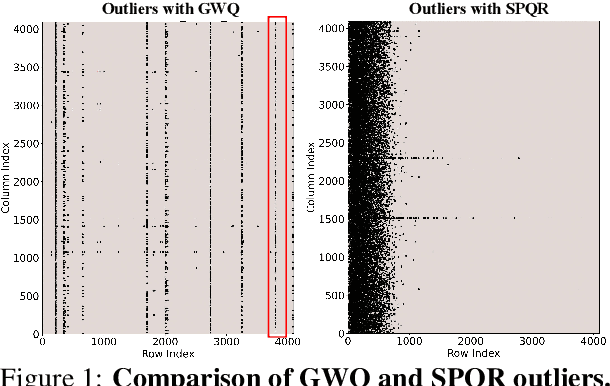
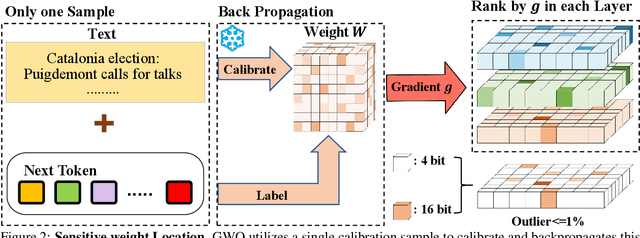
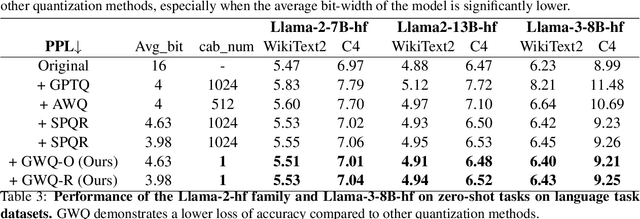
Abstract:Large language models (LLMs) show impressive performance in solving complex languagetasks. However, its large number of parameterspresent significant challenges for the deployment and application of the model on edge devices. Compressing large language models to low bits can enable them to run on resource-constrained devices, often leading to performance degradation. To address this problem, we propose gradient-aware weight quantization (GWQ), the first quantization approach for low-bit weight quantization that leverages gradients to localize outliers, requiring only a minimal amount of calibration data for outlier detection. GWQ retains the weights corresponding to the top 1% outliers preferentially at FP16 precision, while the remaining non-outlier weights are stored in a low-bit format. GWQ found experimentally that utilizing the sensitive weights in the gradient localization model is more scientific compared to utilizing the sensitive weights in the Hessian matrix localization model. Compared to current quantization methods, GWQ can be applied to multiple language models and achieves lower PPL on the WikiText2 and C4 dataset. In the zero-shot task, GWQ quantized models have higher accuracy compared to other quantization methods.GWQ is also suitable for multimodal model quantization, and the quantized Qwen-VL family model is more accurate than other methods. zero-shot target detection task dataset RefCOCO outperforms the current stat-of-the-arts method SPQR. GWQ achieves 1.2x inference speedup in comparison to the original model, and effectively reduces the inference memory.
RenderWorld: World Model with Self-Supervised 3D Label
Sep 17, 2024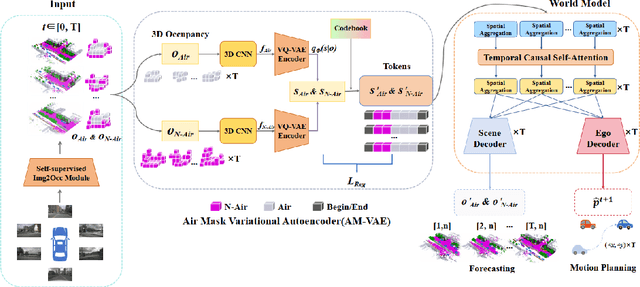
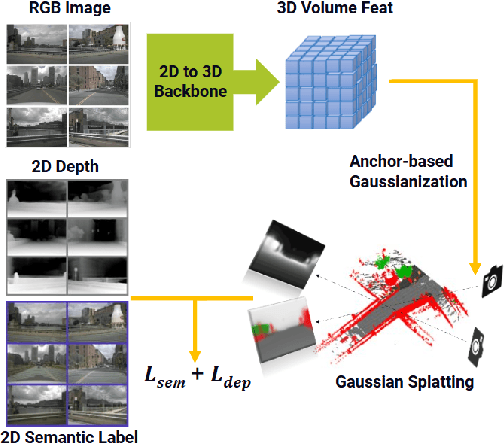


Abstract:End-to-end autonomous driving with vision-only is not only more cost-effective compared to LiDAR-vision fusion but also more reliable than traditional methods. To achieve a economical and robust purely visual autonomous driving system, we propose RenderWorld, a vision-only end-to-end autonomous driving framework, which generates 3D occupancy labels using a self-supervised gaussian-based Img2Occ Module, then encodes the labels by AM-VAE, and uses world model for forecasting and planning. RenderWorld employs Gaussian Splatting to represent 3D scenes and render 2D images greatly improves segmentation accuracy and reduces GPU memory consumption compared with NeRF-based methods. By applying AM-VAE to encode air and non-air separately, RenderWorld achieves more fine-grained scene element representation, leading to state-of-the-art performance in both 4D occupancy forecasting and motion planning from autoregressive world model.
AccidentBlip2: Accident Detection With Multi-View MotionBlip2
Apr 19, 2024Abstract:Multimodal Large Language Models (MLLMs) have shown outstanding capabilities in many areas of multimodal reasoning. Therefore, we use the reasoning ability of Multimodal Large Language Models for environment description and scene understanding in complex transportation environments. In this paper, we propose AccidentBlip2, a multimodal large language model that can predict in real time whether an accident risk will occur. Our approach involves feature extraction based on the temporal scene of the six-view surround view graphs and temporal inference using the temporal blip framework through the vision transformer. We then input the generated temporal token into the MLLMs for inference to determine whether an accident will occur or not. Since AccidentBlip2 does not rely on any BEV images and LiDAR, the number of inference parameters and the inference cost of MLLMs can be significantly reduced, and it also does not incur a large training overhead during training. AccidentBlip2 outperforms existing solutions on the DeepAccident dataset and can also provide a reference solution for end-to-end automated driving accident prediction.
 Add to Chrome
Add to Chrome Add to Firefox
Add to Firefox Add to Edge
Add to Edge